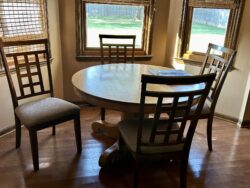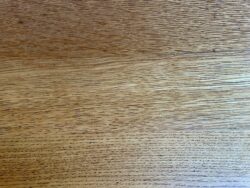Making old things new again
Attending an estate sale is an excellent means of practicing memento mori, the ancient discipline of contemplating one’s inevitable death. Whether you’re the family left behind, the estate sale company workers who plan and execute them, or the buyers who gravitate from sale to sale picking over the material possessions and detritus of a person’s life, there is no dodging the hard facts: someone is dead, and soon, you will be too.
 A fresh wave of awareness of my own inescapable—and ever close—demise washed over me recently when S. and I attended the Joffrion family estate sale. The Reverend Emile Joffrion and his wife Martha had served their beloved church family at the parish of the Church of the Nativity (Episcopal) in Huntsville, Alabama for some 67 years. From their love came seven children, two of whom they buried, both killed in car crashes 18 years apart. They laughed, cried, taught, learned, debated, traveled, made music, mentored, and both witnessed and made history, particularly during the American civil rights movement.
A fresh wave of awareness of my own inescapable—and ever close—demise washed over me recently when S. and I attended the Joffrion family estate sale. The Reverend Emile Joffrion and his wife Martha had served their beloved church family at the parish of the Church of the Nativity (Episcopal) in Huntsville, Alabama for some 67 years. From their love came seven children, two of whom they buried, both killed in car crashes 18 years apart. They laughed, cried, taught, learned, debated, traveled, made music, mentored, and both witnessed and made history, particularly during the American civil rights movement.
But now, just like the large majority of the approximately 117 billion humans who have walked the face of the earth, they were dead. They left behind a legacy, along with a house full of leftover “stuff” that children and grandchildren did not want or just simply could not take. But affairs needed settling and manifold household and personal items sold or donated. Experts were hired, and the word spread. If you sell it, “people will come.”
S and I were “Numbers 24 and 25” among the throng on the first day. I was not sure exactly what we were looking for or might find, but it was still good to be out and about with her. S. had spotted a small, round, white oak kitchen table (oval and a little larger with the extenders) and six mid-century modern chairs on the company website she thought would look nice and work well near our kitchen bay window. Her vision in recent weeks had been to relocate the longer, rectangular pine table gifted to us by dear friends that was a little large for the space to our living room where it would be repurposed for another important task.
We thought the table was priced too high and figured others would too, so we decided to wait. We proceeded to buy all the chairs; they were just what S. was looking for and could compliment either our current table or the one for sale. S. also bought a couple of small bookshelves, along with some of Martha’s watercolor paintings.
She said she would return on the 3rd day when “everything is half-price” to take another look at the table. But on the afternoon of day 2, S. texted me that she would like to make the estate sale company an offer. It was still there, and a friend was at the sale and was willing to help broker a deal.
“I really want it,” she wrote. S. rarely ever says that about anything, so I was quick to reply “Yes!” Faster than you can say “American Express!”, all parties had agreed to split the difference between the day 2 and day 3 prices, and the Joffrion kitchen table was ours.
I should add here that in recent years, Martha had befriended S. at their Nativity book club. S. admired and cherished her keen insights on the “Book of the Month”, sharp wit, and warmth toward all. Even in the twilight of her life, Martha never stopped, teaching, mentoring, and welcoming newcomers into her ever-expanding circle of friends. S.’s reasons for wanting that table went far beyond the fact it would look nice and work well near our kitchen bay window. She does not for a second expect to live to 98, but for the remainders of her days in the ways that matter most, she wants to “be like Martha.”
Day 3 dawned, and we had no way of getting the table home. I took a mental inventory of my friends who might have a pickup truck, and I thought of one who lived about a mile from the Joffrion house who probably would not be caught dead or alive without one. I was right, and he said “Yes, of course.” (“Friends let friends drive their trucks!”)
At this point, I should introduce you to a significant protagonist of our story, our eldest son Dr. D. He happened to be visiting that weekend and gladly consented to help me load the table. As we brought it out of the house and sat it down for a moment, we noticed one side of the octagonal pedestal was cracked where a leg attaches. We only saw it when we turned the table upside down and looked inside the hollow pedestal. With seven other intact sides, the table was in no imminent danger of complete failure, but we knew the weakness could crop up as a problem in the future.
Dr. D. is a pathologist who is adept at diagnosing diseases, both common and rare, and well-versed via countless post-mortems performed in the myriad ways that heart attacks, strokes, cancer, bullets, knives, and blunt trauma can kill a human being. He’s a “doctor’s doctor”, a consultant who makes diagnoses that helps his colleagues save lives, but he doesn’t often have the chance to get “hands-on” and “fix things” in his specialty. For as long as I can remember, he has always figured out how things worked and how to repair them when they didn’t. He inherited his spatial reasoning, fine motor skills, and confidence that he could fix most anything from his grandfathers, not from me. I sensed the wheels turning inside his head. Dr. D., the pathologist, was preparing for surgery.
The next day, we operated. Dr. D. had mapped out a precise surgical plan. He first traced the visible break on the outside of the pedestal onto a piece of paper. He then reversed it so he could sketch a second diagram of the crack in its proper orientation on the inside of the black oak splint he would use to support the pedestal. That would enable him to determine the best placement of the bolts he would put into the splint to bolster the break and reattach the leg. I was his assistant, handing him tools, bolts, nuts, and screws, and supplying head and wrist bands for “sweat management” that probably hadn’t seen any action since 1978. I swiped our Home Depot card for tools and hardware—twice—because, as these things go, we discovered the need for a certain size screw we had not anticipated, so it took two trips.
The “furniture-saving orthopedic surgery” was a success. “This table may break someday, but it won’t be there!” Dr. D. pronounced to the relieved, adoptive family of the kitchen table as he pointed toward the repaired breach. He was clearly pleased and grateful for an afternoon spent imparting new life rather than keeping company with death, his all too frequent companion.
Would that all fractures, fragmentations, fissures, gaps, cracks, and chasms which cripple and threaten to swallow us whole could be closed by a smart and multitalented mind, gifted hands, elbow grease, and a couple of trips to Home Depot. A table is small and relatively easy to fix in comparison. But we must start somewhere and choose that which is within our reach and control. “Maybe any labor that adds a little beauty and order to a creation that trends toward chaos can ultimately be meaningful and redemptive.”
Through our friend who had helped us make the deal, we learned that one of the Joffrion daughters, who would have liked to have taken the table herself had she had the space, was thrilled it had landed in a loving home and was receiving another chance. As far as she could recall, it had been the only one in their kitchen since around 1960.

Oh, if that table could talk! It is the color of warm cinnamon toast, and it contains within its variably-striped, open-pore planks the echoes of a busy, happy household and countless conversations between a man who drank whiskey and played poker with the Reverend Will Campbell and writer William Faulkner as they plotted to foil the plans of segregationists in Jim Crow Mississippi and a woman who raised and nurtured both her children and a community, teaching them not only lessons in music and the humanities, but also a master class in remaining a faithful and loving servant-leader even in the midst of tragedy.
There were likely dark moments when both of them had great doubts and difficulties believing a long ago, misty promise of “old things becoming new again”—but nevertheless, they persisted.
The table does indeed look nice and works well near our kitchen bay window, almost like it was meant to be. Its small footprint and roundness makes for more free space, intimate meals, and lively banter.
It also provides a fresh altar for early morning coffee, reading, and meditation. I do not know if the dead can talk, but I can still imagine a spirit visit from Martha and Emile near dawn’s early light. I can see them clear as day sitting there in those mid-century modern chairs feeding us with the leavening manna-words of an ancient saint: “All shall be well, and all shall be well, and all manner of thing shall be well.”
It is a haunting we would gladly welcome.
